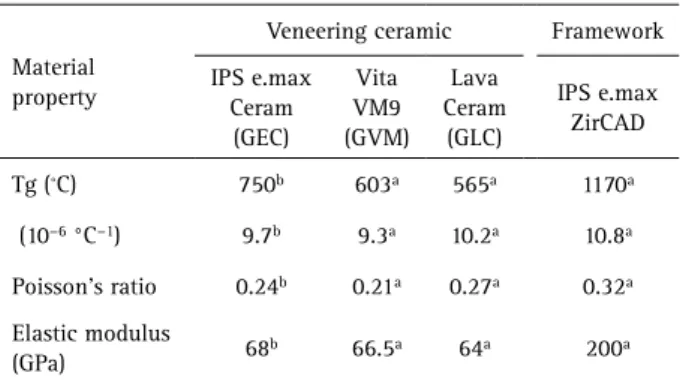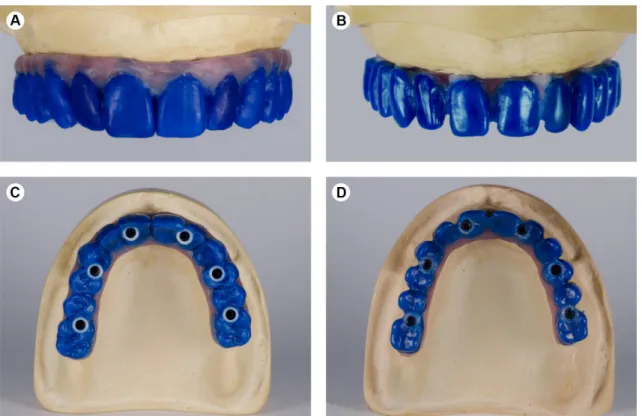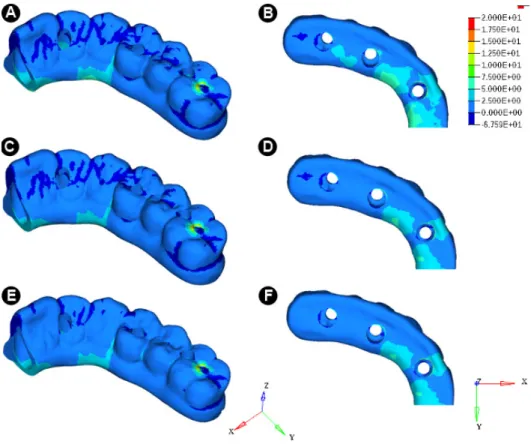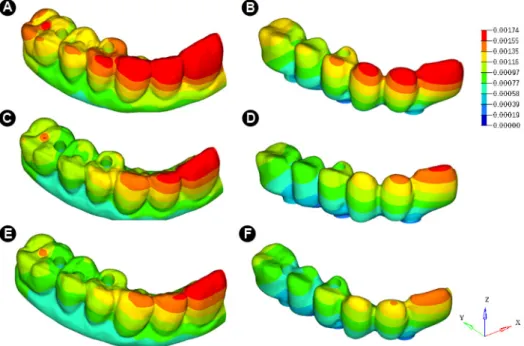The aim of this study was to evaluate the influence of the coefficient of thermal expansion (CTE or α) and glass transition temperature (Tg) of three veneering ceramics used with zirconia frameworks of full-arch fixed prostheses. The generation of residual stresses and linear contraction after the simulation of the cooling process and mechanical loading were measured. The analysis was based on the finite element method in three-dimensional model of a maxillary full-arch fixed prosthesis with zirconia framework (e.max ZirCAD) and veneer by felsdpathic ceramics (GEC - IPS e.max Ceram, GVM - Vita VM9 and GLC - Lava Ceram). The linear contraction simulation was performed by cooling the structures from the Tg of each veneer ceramic at room temperature (25°C). A loading of 100 N on the occlusal region of the first molar was performed. The magnitude of the maximum principal stress (smax) and linear contraction were evaluated. The levels of CTE mismatch between veneering ceramics and framework showed no relevant influence on smax and linear contraction. The Tg values of the veneer ceramic showed to be directly proportional to amount of smax and linear contraction. The GEC presented the highest values of smax
and linear contraction. The GVM and GLC did not present significant differences between them. In conclusion, GVM was similar to GLC, while GEC presented differences in relation to other veneer ceramics in terms of residual stress and linear contraction.
C h a r a c t e r i z a t i o n o f R e s i d u a l
Stresses in Veneering Ceramics for
Prostheses with Zirconia Framework
Vagner Flávio Reginato¹, Daniel Takanori Kemmoku², Ricardo Armini Caldas¹,
Ataís Bacchi³, Carmem Silvia Pfeifer4, Rafael Leonardo Xediek Consani¹
¹Department of Prosthodontics and Periodontology, Piracicaba Dental School, UNICAMP – Universidade Estadual de Campinas, Piracicaba, SP, Brazil ²CTI Renato Archer - Centro de Tecnologia da Informação Renato Archer, Campinas, SP, Brazil ³Department of Prosthodontics, IMED - Faculdade Meridional, Passo Fundo, RS, Brazil
4Department of Restorative Dentistry,
Division of Biomaterials and Biomechanics, Oregon Health and Science University, Portland, OR, USA
Correspondence: Rafael Leonardo Xediek Consani, Av. Limeira, 901, 13414-903, Piracicaba, SP, Brasil. Tel: +55-19-2106-5296. e-mail: rconsani@fop.unicamp.br
Key Words: veneer ceramic, finite element analysis, dental implant, complete denture, zirconia.
Introduction
All-ceramic dental prostheses have been widely used due to the combination of aesthetic properties, flexural strength and biocompatibility (1). As an alternative for the metallic frameworks, the use of yttria-stabilized polycrystalline tetragonal zirconia (Y-TZP) has increased (2), due to its high resistance to fracture (3), and indication for manufacturing of frameworks for single, partial or full-arch fixed prostheses.
However, the incidence of failures occurring in veneering ceramics on zirconia frameworks has been considered as an unsolved problem for the clinical success of this restoration type (4), presenting higher failure rates (6% to 15% in periods of 3 to 5 years) than those found for metal-ceramic prostheses (4% of failures after 10 years) (5). Generally, the clinical failures of bi-layered all-ceramic dental prostheses with zirconia frameworks are the fracture (chipping), cracking or delamination of the veneer ceramic (2,6,7).
Several factors have been suggested as causes for fractures, cracks or delamination in veneer ceramics such as: thermal expansion mismatch between framework and veneer ceramic (8-10), excessive veneer ceramic thickness (6), inadequate geometry of the frameworks (not anatomical) promoting lack of support for the veneer ceramic (11-14), inadequate cooling protocol (15-17) and
improper firing process (18).
It is possible for clinicians and technicians to control some variables such as ceramic thickness, anatomical frameworks, cooling protocol, and a suitable firing process. However, one of the factors considered as the main responsible for the failures in clinical conditions is the residual stress between framework and veneer ceramic occurred during the firing process, which depends also on some properties of the materials (9). This stress has been credited to difference in the CTE of the zirconia and of the veneer ceramic because the structures do not contract in the same proportion (19). It is important also to note that the CTE of the ceramics is measured in degrees, thus the Tg of each ceramic must be taken into account as a factor that will influence the final contraction value of the ceramics (7,20).
The stress generated in the firing cycle of each coating layer of the veneer ceramic is not considered as a significant factor for the prostheses contraction due to the heating of the next firing process, which relief the residual stress of the previous layer. Therefore, it has been alleged that the residual stress related to cracking, fracture or delamination of this type of prostheses is associated to the last firing process (17).
V
. F
. Reginato et al.
is slightly higher that of the veneer ceramic (ɑ framework
-ɑ veneer =+△ɑ) (7,9,10); however, few studies have been
published with the main purpose of to determine the limit values of CTE mismatch (7,9).
The thermal compatibility of bi-layered all-ceramic dental prostheses was evaluated by measuring the
deflection of disks varying the △ɑ from -3.7 to 3.8 ppm
/°C-1 between framework and veneer ceramic. In this previous study was observed that the deflection of the disks is related to the values of thermal incompatibility between framework and veneer ceramic; however, the same happened for the control group in a lower value (characterized by the combination of ceramics indicated by the manufacturer). The authors alleged that even the manufacturer’s recommended value would not be sufficient to predict the compatibility between framework and veneer ceramic (21).
The size of the framework may influence the amount of stress, and it is possible that frameworks used for full-arch implant-supported all-ceramic rehabilitation tend to provide different magnitude of stresses than single crowns; however, this type of rehabilitation has not yet been evaluated in the literature. It is worth mentioning that the prostheses acting as a support structure also receive masticatory loads; therefore, not only the residual stress from the manufacturing process is a significant factor on the compatibility between framework and veneer ceramic, but also the tensions generated by the mastication effort.
For a better understanding of these interactions, the purpose of this study was to evaluate the influence of the CTE mismatch and Tg between zirconia framework and veneer ceramic in the residual stress in bi-layered full-arch fixed prostheses after simulated cooling process and mechanical loading by means of finite element analysis (FEA).
Material and Methods
Confection of the Geometric Model
A three-dimensional model was fabricated for a full-arch rehabilitation in maxilla. A full-full-arch implant-supported prosthesis was waxed on six implants equidistantly distributed (FIg. 1). The positioning of the implants and the preparation of the prostheses were performed based on an edentulous maxilla study model.
The confection of the geometric model was carried out in two stages to obtain the dimensions of the framework and the veneer material. For convenience reasons, the prostheses were firstly waxed in its final shape (veneer final dimension), and then reduced in two millimeters (mm) to obtain the framework final dimension.
Both structures were scanned using a 3D scanner (MODELA MDX-20; Roland DG, Shizuoka, Japan) and the
geometries were imported into the Autodesk Meshmixer 3.0 software (San Diego, USA) to generate the final post-scan images. Further corrections were made on the original geometry in Rhinoceros 5.0 to remove inappropriate surfaces, which would hamper the generation of a quality mesh (Fig. 2).
Finite Element Analysis (FEA)
After the 3D model assembly, the files were exported to pre-processing software (Hypermesh 14.0 HyperWorks 14.0 - Altair; Troy, MI, USA), where the boundary conditions, material properties and loading conditions were defined. The mesh was defined as tetrahedral elements with 10 nodes with a minimum element size of 0.15 mm and a maximum of 0.25 mm, totaling 1,522,898 nodes and 1,002,115 elements. The geometric model was sectioned at sagittal plane and symmetric condition applied.
The FEA simulations were a two-step process, performed by cooling process and followed by mechanical loading. For the analysis, all materials were considered linearly elastic, isotropic and homogeneous. The analyzed groups were defined by the variation of the veneering ceramics, using three different commercially available feldspathic ceramics: GEC - IPS e.max Ceram (Ivoclar Vivadent), GVM - Vita VM9 (Vita), and GLV - Lava Ceram (3M ESPE). For all analyzes were used zirconia framework (IPS e.max ZirCAD - Ivoclar Vivadent). The veneering materials were adopted with CTE
smaller to the framework (ɑ framework - veneer=△ɑ+)
at levels of △ɑ+0.6 ppm °C-1 (Lava Ceram), △ɑ+1.1 ppm
°C-1 (IPS e.max Ceram) and △ɑ+1.5 ppm °C-1 (Vita VM9),
representing approximately 5,10 and 15% less than the framework, respectively. In addition, the veneering ceramics used in the current study presented non-uniform variation for Tg. Table 1 shows the mechanical properties of these materials.
The simulation of the cooling process was performed from the Tg of each veneer ceramic, since there is no production of residual stress above the Tg due to the
Table 1. Mechanical properties of the materials
Material property
Veneering ceramic Framework
IPS e.max Ceram
(GEC)
Vita VM9 (GVM)
Lava Ceram (GLC)
IPS e.max ZirCAD
Tg (◦C) 750b 603a 565a 1170a
(10−6 °C−1) 9.7b 9.3a 10.2a 10.8a
Poisson’s ratio 0.24b 0.21a 0.27a 0.32a
Elastic modulus
(GPa) 68
b 66.5a 64a 200a
Stresses in ceramics for prostheses with zirconia viscoelastic property of the ceramic at that temperature,
that is, the ceramic is not yet a solid, so there is no tension formation (22). The Tg was decreased at room
temperature of 25°C, adopting the variation ∆θ for this
difference of values (Dq=Tg – 25). After cooling simulation, the mechanical loading was applied generating results influenced by both phenomena. For the mechanical loading simulation, an axial force of 100 N was applied on the first molar unilaterally and the prosthetic abutments site was considered as fixed support (no degrees of freedom).
The FEA processing was performed by the software Optistruct (HyperWorks 14.0 – Altair; Troy, MI, USA), and
the results of maximum principal stress smax and linear
contraction were analyzed in the post-processing software HyperView (HyperWorks 14.0).
Results
Maximum Principal Stress (σmax)
Values for σ max are shown in Table 2. The GEC showed
the highest value of σ max both in the veneer ceramic or
in the framework. GVM and GLC with lower values did not present any relevant difference between them. The residual stress results were shown to be directly proportional to the Tg of the veneer ceramic and were not significantly influenced by the CTE mismatch.
The higher concentrations of residual stress in the veneering ceramics occurred in the regions of occlusal
loading (Figs. 3 and 4), and at the base of the prostheses (Fig 3). For the framework, the higher stress was in regions of the abutments (Fig. 5).
Linear Contraction
The amount of linear contraction of the veneering ceramics and of the framework was directly influenced by the Tg values of the veneer ceramic; however, it was not influenced by the CTE mismatch evaluated. The values obtained in the thermal contraction analysis are shown in Figure 6 and Table 2. The main regions of linear contraction occurred at the dental structures, especially in the anterior teeth.
D
iscussion
It was observed that the Tg of the veneering ceramic
influenced the σmax, linear contraction and the region of
Table 2. Maximum principal stress and linear contraction in the veneering ceramics and framework
IPS e.max Ceram
(GEC)
Vita VM9 (GVM)
Lava Ceram (GLC)
Linear contraction
(mm) 0.00226 0.00181 0.00174
Maximum Principal
Stress (MPa) 2939 2366 2235
V
. F
. Reginato et al.
maximum residual stresses during the simulated cooling in FEA method. Therefore, the residual stresses in the prostheses were dependent on the temperature that the
cooling simulation was started; that is, the higher the Tg, the greater the final stresses and contraction values. The ceramic cooling procedure is important to prevent failures in clinical applications, considering that the ceramic Tg increase with faster cooling rates and slow cooling appears to be especially important for all-ceramic crowns to prevent high magnitude thermal gradients, which could influence cracking and fracture of the porcelain (2). The bond strength between the zirconia core and the veneer decreases with the slow cooling rate, indicating that slow cooling may increase the risk of adhesive delamination failures between the core and veneer (17). Moreover, thermal compatibility of dental ceramic systems with different geometries showed low residual stress in specimens that did not fail and high residual stress in the specimens with failures (9).
In the analysis with the GEC, which represents the combination of the same manufacturer for veneer ceramic
and framework, the highest values for smaxand linear
contraction either in the veneering ceramics or in the framework were observed. This is credited to the fact that GEC has the higher Tg (750°C), resulting in a higher value of Dq. The GLC was the group with the lowest values of
smaxand linear contraction in the veneer ceramic and
framework, credited to the lower Tg value (565°C). Although the GVM showed a larger CTE mismatch between veneer
ceramic and framework (△ɑ+1,5 ppm/°C-1) when compared
Figure 2. Finite element mesh: (A) veneer ceramic and (B) framework.
Stresses in ceramics for prostheses with zirconia
with GEC (△ɑ+1,1 ppm °C-1), it was observed lower values
of stress and linear contraction due to its lower Tg (603 °C). Despite the framework for the GLC and GVM groups to be composed by the same material for framework (IPS e.max ZirCAD), the veneer ceramics are from different manufacturers. Probably, this variable was also responsible for these results. In addition, CTE levels evaluated showed no significant influence on residual stresses in all groups analyzed.
The findings of this study are in agreement with a previous report, which suggested that Tg influences the total value of contraction between veneer ceramic and framework materials, causing higher stress. In addition, it was reported a correlation between the thermal properties (Tg) of the veneering ceramics and the shear strength of zirconia/veneer ceramic composites, and no clear correlation between shear strength and CTE mismatch was shown (7).
Ereifej et al. (23) compared two ceramic core/veneer interfaces with different CTE and its relationship with the shear bond strength: for both groups, the veneer was e.max
Ceram (CTE 9.4 ppm/°C-1) and the core varied between e.max
ZirCAD (CTE 10.8 ppm/°C-1), and e.max CAD LS/Ceram (CTE
10.45 ppm/°C-1). However, despite of mismatch CTE between
ceramics, the authors showed no statistically significant difference between the groups in shear stresses for e.max ZirCAD and e.max CAD LS/Ceram. Based on these findings, it might be suggested that there is a range of CTE mismatch considered acceptable for practical application.
Moreover, the acceptable mismatch could be related also to the size of the restoration (single, partial, or complete arch), which has not been considered in literature. However, framework and veneer ceramic with compatible CTE show great values of deflection in discs, and the same occurred
in larger CTE mismatches (from -3.7 to 3.8 ppm/oC-1).
Thus, CTE is not enough to predict compatibility because other variables like viscoelastic behavior of ceramic and laboratory procedures are relevant (21).
In contrast, it was observed a significant influence of
CTE mismatch on contact angle measurement and the shear bond strength of core-veneer ceramics (10). In addition, the CTE mismatch between core and veneer, associated
to differences between the Tg at room temperature
may have an impact on stress formation in the sample. Residual stress at the veneer layer was responsible for the increased strength and observed chipping in bi-layer ceramic composites (8). Another significant fator was that the hoop tensile stresses generated in the veneering layer
during fast cooling protocols due to porcelain high ∆α/α
solid ratio will facilitate flaw propagation from the surface toward the core, which negatively affects the potential
V
. F
. Reginato et al.
Figure 6. Linear contraction analysis: (A) IPS e.max Ceram (veneer ceramic), (B) IPS e.max Ceram (framework), (C) Vita VM9 (veneer ceramic) e (D) Vita VM9 (framework), (E) Lava Ceram (veneer ceramic) and (F) Lava Ceram (framework).
clinical longevity of the crown (22). However, another study showed that the fracture modes observed matched with clinical scenarios (14).
However, the influence of CTE on the residual stress on bi-layered all-ceramic dental prostheses will depend on the amount of the mismatch value, and the CTE mismatch of the framework and veneer ceramic used in this current study does not show influence on the residual stresses and thermal contraction. Moreover, previous study showed that
a higher mismatch change between the ceramics (ɑ core-ɑ
veneer=+△ɑ), using CTE mismatch values positive (+3.8 ppm
/°C-1) and negative (-3.7 ppm /°C-1), has a larger deflection
of the ceramic flat core, besides the significant contraction caused also by core and veneers with compatible CTE (21).
Different factors may influence clinical failures in veneered ceramic systems, and only CTE mismatch would not be sufficient to predict clinical failures or the success of all-ceramic systems. However, several values have been
suggested as safe CTE mismatch in literature, such as △ɑ
+1.0 ppm/°C-1 (6), △ɑ −0.61 ppm/°C-1 to +1.02 ppm/°C-1
(9), △ɑ ±0.6 ppm/°C-1 (24), and △ɑ +0.3 ppm/°C-1 (25).
Moreover, any linear distortion of the layered ceramic structure during the processing method should be avoided to obtain clinical longevity in zirconia all-ceramic bi-layered restoration (21). It is possible that the CTE smaller for veneering materials when compared to the framework base has been responsible for the similar results when compared to those reported in the literature (6,9,24,25).
By this reason, the region submitted to occlusal load and the prostheses base promoted higher stress concentration
Stresses in ceramics for prostheses with zirconia residual stress. The linear contraction was higher at regions
of the anterior teeth for both structures.
The cooling rates of the ceramics are not considered in the simulation of the current work; therefore, this fact can be considered as a limitation of the study. For the cooling process, the difference of the Tg at room temperature
(Dq=Tg – 25) was considered, and no cooling rate was
adopted. However, it was supposed that the limitation would not interfere in the results because it was assumed equal for all groups. In addition, only occlusal static loading was applied.
Previous work using 3-point bending showed that the
ceramic thickness influences the mean σ values and the
failure mode was fracture initiation at the porcelain surface propagating to the framework interface (11). In clinical conditions, the masticatory cycles involve dynamic loads, which may result in different biomechanical behavior and stress distribution for bi-layered all-ceramic restorations, resulting different mode of failures. Considering the conditions evaluated in this study, the following conclusion may be drawn: GVM was similar to GLC, while GEC presented differences in relation to other veneer ceramics in terms of residual stress and linear contraction.
Resumo
O objetivo neste estudo foi avaliar a influência do coeficiente de expansão térmica (CET) e da temperatura de transição vítrea (Tg) de três cerâmicas feldspáticas utilizadas para o recobrimento da infraestrutura de zircônia em prótese total fixa. A tensão residual e contração linear após a simulação do processo de esfriamento e carga oclusal foram mensuradas. A análise foi efetuada pelo método por elementos finitos num modelo tridimensional de uma prótese total maxilar com infraestrutura em zircônia (e.max ZirCAD) recoberta por três cerâmicas felsdpáticas (GEC - IPS e.max Ceram, GVM - Vita VM9 ou GLC - Lava Ceram). A simulação da contração linear foi realizada pelo esfriamento da estrutura a partir da Tg de cada
cerâmica de cobertura até a temperatura ambiente (25 °C). Em seguida,
um carregamento de 100 N foi realizado na região oclusal de primeiro
molar. A magnitude da tensão máxima principal (smax) e contração
linear foram avaliadas. Os níveis de diferença de CTE entre cerâmica de cobertura e infraestrutura não apresentaram influência significante na
smax e na contração linear. Os valores da Tg da cerâmica de cobertura
foram diretamente proporcionais à quantidade de smax e contração linear.
O grupo GEC apresentou os maiores valores de smax e contração linear,
enquanto os grupos GVM e GLC com menores valores não apresentaram diferenças significantes entre si. Em conclusão, o grupo GVM foi similar ao GLC, enquanto o grupo GEC apresentou diferenças em relação a outras cerâmicas de cobertura quanto à tensão residual e contração linear.
References
1. Dittmer MP, Borchers L, Stiesch M, Kohorst P. Stresses and distortions within zirconia-fixed dental prostheses due to the veneering process. Acta Biomater 2009;5:3231-3239.
2. Benetti P, Kelly JR, Della Bona A. Analysis of thermal distributions in veneered zirconia and metal restorations during firing. Dent Mater 2013;29:1166-1172.
3. Kelly JR, Denry I. Stabilized zirconia as a structural ceramic: an overview. Dent Mater 2008;24:289-298.
4. Della Bona A, Kelly JR. The clinical success of all-ceramic restorations. J Am Dent Assoc 2008;139Suppl:8S-13S.
5. Sorrentino R, De Simone G, Tetè S, Russo S, Zarone F. Five-year prospective clinical study of posterior three-unit zirconia-based fixed dental prostheses. Clin Oral Investig 2012;16:977-985.
6. Swain M V. Unstable cracking (chipping) of veneering porcelain on all-ceramic dental crowns and fixed partial dentures. Acta Biomater 2009;5:1668-1677.
7. Fischer J, Stawarzcyk B, Trottmann A, Hämmerle CHF. Impact of thermal misfit on shear strength of veneering ceramic/zirconia composites. Dent Mater 2009;25:419-423.
8. Taskonak B, Mecholsky Jr. JJ, Anusavice KJ. Residual stresses in bilayer dental ceramics. Biomaterials 2005;26:3235-3241.
9. DeHoff PH, Barrett AA, Lee RB, Anusavice KJ. Thermal compatibility of dental ceramic systems using cylindrical and spherical geometries. Dent Mater 2008;24:744-752.
10. Benetti P, Della Bona A, Kelly JR. Evaluation of thermal compatibility between core and veneer dental ceramics using shear bond strength test and contact angle measurement. Dent Mater 2010;26:743-750. 11. Benetti P, Pelogia F, Valandro LF, Bottino MA, Bona A Della. The effect
of porcelain thickness and surface liner application on the fracture behavior of a ceramic system. Dent Mater 2011;27:948-953. 12. Bonfante EA, Rafferty B, Zavanelli RA, Silva NRFA, Rekow ED, Thompson
VP. Thermal/mechanical simulation and laboratory fatigue testing of an alternative yttria tetragonal zirconia polycrystal core-veneer all-ceramic layered crown design. Eur J Oral Sci 2010;118:202-209. 13. Shirakura A, Lee H, Geminiani A, Ercoli C, Feng C. The influence of
veneering porcelain thickness of all-ceramic and metal ceramic crowns on failure resistance after cyclic loading. J Prosthet Dent 2009;101:119-127.
14. Silva NRFA, Bonfante E, Rafferty BT, Zavanelli RA, Martins LL, Rekow ED. Conventional and modified veneered zirconia vs. metalloceramic: fatigue and finite element analysis. J Prosthodont 2012;21:433-439. 15. Silva NRFA, Bonfante EA, Rafferty BT, Zavanelli RA, Rekow ED,
Thompson VP. Modified Y-TZP core design improves all-ceramic crown reliability. J Dent Res 2011;90:104-108.
16. Guazzato M, Walton TR, Franklin W, Davis G, Bohl C, Klineberg I. Influence of thickness and cooling rate on development of spontaneous cracks in porcelain/zirconia structures. Aust Dent J 2010;55:306-310. 17. Göstemeyer G, Jendras M, Dittmer MP, Bach F-W, Stiesch M, Kohorst P.
Influence of cooling rate on zirconia/veneer interfacial adhesion. Acta Biomater 2010;6:4532-4538.
18. Cheung KC, Darvell BW. Sintering of dental porcelain: effect of time and temperature on appearance and porosity. Dent Mater 2002;18:163-173.
19. Bonfante EA, Rafferty BT, Silva NRFA, Hanan JC, Rekow ED, Thompson VP. Residual thermal stress simulation in three-dimensional molar crown systems: a finite element analysis. J Prosthodont 2012;21:529-534.
20. Fischer J, Stawarczyk B, Tomic M, Strub JR, Hämmerle CHF. Effect of thermal misfit between different veneering ceramics and zirconia frameworks on in vitro fracture load of single crowns. Dent Mater J 2007; 26:766-772.
21. Isgrò G, Wang H, Kleverlaan CJ, Feilzer AJ. The effects of thermal mismatch and fabrication procedures on the deflection of layered all-ceramic discs. Dent Mater 2005;21:649-655.
22. Meira JBC, Reis BR, Tanaka CB, Ballester RY, Cesar PF, Versluis A. Residual stresses in Y-TZP crowns due to changes in the thermal contraction coefficient of veneers. Dent Mater 2013;29:594-601. 23. Ereifej N, Rodrigues FP, Silikas N, Watts DC. Experimental and FE
shear-bonding strength at core/veneer interfaces in bilayered ceramics. Dent Mater 2011;27:590-597.
24. Steiner PJ, Kelly JR, Giuseppetti AA. Compatibility of ceramic-ceramic systems for fixed prosthodontics. Int J Prosthodont 1997;10:375-380. 25. Belli R, Frankenberger R, Appelt A, Schmitt J, Baratieri LN, Greil P.
Thermal-induced residual stresses affect the lifetime of zirconia-veneer crowns. Dent Mater 2013;29:181-190.




